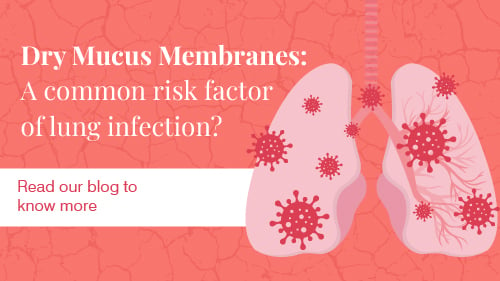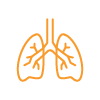Lung Infections: Symptoms, Causes, and Treatment
January 28, 2025

Lung illnesses, such as pneumonia, are common types of lung infections caused by viruses, bacteria, or fungi. Pneumonia, often caused by bacteria but sometimes by viruses, occurs when a person breathes in infectious particles released through coughing or sneezing. Lung infection symptoms may include coughing, fever, shortness of breath, and chest pain.
A lung infection occurs when a harmful microorganism, such as a bacterium or virus, gets into the lungs and causes damage. The severity of an infection in the lungs can range from mild to life-threatening.
Pneumonia is an infection of the lungs that can cause inflammation. In pneumonia, the lungs’ air sacs can get inflamed. This can cause the lungs to fill up with air, making breathing difficult.
Bacteria, fungi, and viruses can cause pneumonia. For example, Streptococcus pneumoniae can cause bacterial pneumococcal pneumonia. The COVID-19 respiratory disease caused the pandemic.
Symptoms
Various symptoms are associated with a lung infection, from mild to severe. This is based on your age, overall health, and the cause of the infection. The cold or flu symptoms may be similar but tend to last longer.
- Body Ache: You may experience pain in your muscles and back when you have a lung infection. This is a pain in myalgia.
- Bluish Appearance of the Skin or Lips: The color of your lips or nails may be bluish due to a lack of oxygen.Sometimes, you can develop inflammation in your muscles, which can cause pain when you have an infection.
- Chest Pain: Patients may experience sharp or stabbing pain that intensifies with deep breaths or coughing.
- Chills (severe colds may be called chills): These can occur when the fever increases, and sometimes sweats (soaked sweats) can occur when the fever goes down.
- Cough: The cough may be either dry or “wet” (mucus-producing) or mild or severe.
- Cyanosis: A bluish tint to the lips, skin, or nails, which is a sign of low oxygen levels.
- Fatigue: A feeling of persistent tiredness that results from the body’s immune response.
- Fever can be mild (temperature is below 100 degrees F), moderate (temperature is between 101 and 103 degrees F), or high (temperature is above 104 degrees F).
- Mucus Production: It may vary, but it is often clear, yellow, green, brown, or rusty without an odor.
- Shortness of Breath means you feel like it’s difficult to breathe or that you can’t breathe in fully. Seek medical attention immediately if you experience difficulty breathing.
- Symptoms of the Upper Respiratory Tract: nasal congestion, sore throat, hoarseness, laryngitis, and headache are common, especially viral infections.
- Wheezing: A wheezing cough is most characteristically heard during expiration, but sometimes it may also occur during both inspiration and expiration. Inspiration-generated wheezing often produces a high-pitched sound called stridor, which is commonly associated with infections of the upper airway above the lungs, such as in the trachea tube seen in epiglottitis or influenza. Treatment for wheezing is determined by its cause and may require anti-inflammatory medicines, agents to open the airways, and antibiotics that target the infection.
Less common symptoms might include coughing up blood, rapid breathing, nausea, confusion, especially in the elderly, and clubbing of fingers or toes in chronic conditions, which require immediate medical help.
Therefore, persistent symptoms or worse symptoms, such as high fever or severe difficulty in breathing, should be seen by a doctor since some diseases, such as lung cancer, can mimic the symptoms of lung infections. Proper diagnosis and treatment are the keys to proper management and recovery.
Causes
A very common pulmonary disease is pneumonia. It is caused by infectious pathogens like bacteria and viruses. Such pathogens are spread through coughing, sneezing, or contact with contaminated surfaces. On entering the human body, germs move up the lungs until they get inside the small air sacs, where they activate the immune system, which in turn sends white blood cells to fight this infection. This response results in inflammation; hence, alveoli get filled up with fluid and pus, thus causing pneumonia. Symptoms of pulmonary infections include coughing, chest pains, fever, and difficulty breathing. Treatment for pneumonia is administered with antibiotics for bacterial infections, antiviral drugs for viral causes, and supportive treatment to alleviate symptoms.
Risk Factors
Risk factors for lung infections can change based on a particular infection, but some common factors increase some, if not all, of these infections.
Common risk factors are:
- Exposure to smoking or indirect smoking
- Exposure to air pollution or dust in the workplace
- History of asthma or allergies
- Crowded living environment
- Northern Hemisphere winter moon
- Dry mucous membrane
- Gastroesophageal reflux disease (GERD)
- Face, head, neck, or airway-related anatomical problems, including problems such as nasal polyps
Risk Factors of Lung Infection in Children
Risk factors present primarily in children include:
- Increased exposure through daycare, school, or multiple sibling settings
- being a man
- prematurity
- Bottle feeding (instead of breastfeeding)
- pacifier use
- Age (children under 6 years of age are generally more susceptible, and bronchiolitis occurs more frequently in younger children under two years)
- Children born to mothers who smoke during pregnancy
- Congenital heart and/or lung disease
Treatment
A bacterial infection typically requires antibiotics for treatment, while a fungal lung infection is treated with antifungal medications like ketoconazole or voriconazole.
Antibiotics won’t work on viruses. In most cases, you have to wait until your body fights off the infection on its own. At the same time, you can help your body fight infection and make yourself more comfortable with the following home care remedies:
- Take acetaminophen or ibuprofen to reduce fever
- Drink a lot of water
- Try hot tea with honey or ginger
- Gargle with salt water
- Rest as much as possible
- Use a humidifier to create moisture in the air
- Take any prescription antibiotics until they go away
Prevention
What can I do to avoid getting sick with upper respiratory infections?
Stay healthy and stay together. Protect your health by avoiding contact with people who are sick. Drink more water. Get enough sleep; stop smoking.
Summary
Lung infections can be severe, often spreading deep into the lungs or traveling to the bloodstream. It can be dire when damage occurs to other organs due to a disease. However, there is no need to worry if you don’t receive prompt medical care, as it can be very lifesaving. If a person suspects a lung infection, they should call a doctor.
When Should I See a Doctor for a Lung Infection?
You should seek medical attention if you notice:
- Difficulty breathing or shortness of breath
- A persistent high fever (over 102°F)
- Chest pain that gets worse with breathing or coughing
- Bluish lips or nails
- Symptoms that last more than a few days without getting better
Getting help early can prevent complications and lead to better outcomes.
Frequently Asked Questions
1. How severe is a lung infection?
The severity of a lung infection can vary from mild to life-threatening. Although most lung infections are treatable and most people recover, these infections are also dangerous. In addition, people with weakened immune systems are especially vulnerable to catching colds.
2. What does the start of a lung infection feel like?
Fever, sweating, and shaking chills. Shortness of breath. Rapid, shallow breathing. Sharp or stabbing chest pain worsens when you breathe deeply or cough.
3. What is the recovery time for a lung infection?
The recovery time for a lung infection varies based on its type, your age, and overall health. Acute lung infections typically resolve within a few days to a few weeks, whereas chronic lung infections may persist for months or even years.







